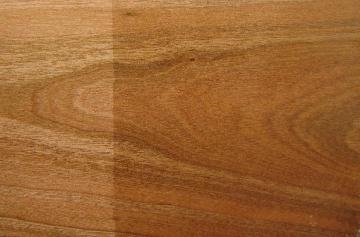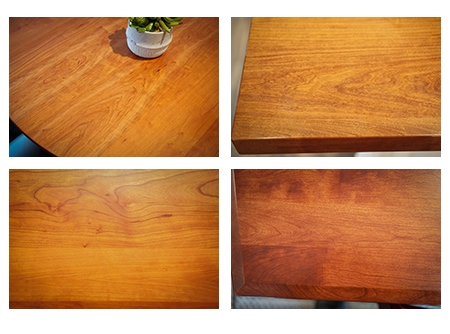Cherry Wood Furniture
Are you as charmed by cherry wood furniture as we are? We can understand why. Cherry wood furniture is elegant, timeless, natural and strong. Considered one of the softer hardwoods, it still offers plenty of durability. Cherry is known for its strength and beauty and is one of the most desired woods for solid wood furniture.
A magical wood that changes color with light,
A balance of strength and substance that’s always just right,
From a tree that bears tiny tart berries,
Come the elegant shades of a wood known as cherry.
The Look of Cherry Wood Furniture
What Color is Cherry Wood?
Cherry wood includes stunning shades that range in color from blond to reddish brown. Cherry furniture will darken over time depending on its exposure to light. The degree of darkening varies from tree to tree.
This darkening process contributes to making cherry wood one of the most intriguing, sought after wood types for solid wood furniture. While many love the darkening process, it is important to monitor the exposure of cherry wood furniture to light so that any darkening occurs evenly.
The heartwood (wood closest to the center of the log) starts out a light pinkish brown that develops into a rich reddish brown shade over time. The sapwood of the cherry tree is a creamy pale yellow color. Cherry wood colors vary from tree to tree and even among boards from the same cherry tree.
If you're attracted to the deep red color of the cherry fruit, that's actually achieved by the stain more than the wood type. While Cherry wood's grain and subtle red tones look great in a red stain, the deep red coloring can be achieved with other wood types as well based on your choice of stain.

This image shows the difference between newly finished cherry wood and cherry after it has naturally darkened.
Cherry Wood Grain
Cherry wood has a fine, straight grain. Its simple, smooth and closed grain pattern is similar to maple wood. The uniform wood grain has a smooth texture. There may be some pith flecks (worm tracks that create a little brownish streak), mineral deposits, or gum pockets in cherry wood as well as the occasional knot.
Mineral deposits (also called pitch pockets or sap pockets) are little black spots that can occur randomly in cherry wood. They are where sap was stored at one time. Pitch pockets add some texture to cherry wood furniture.
Though you will usually see a variety of these grain variations in cherry furniture, the wood can sometimes be selected based on the grain characteristics you prefer. Here at DutchCrafters, in addition to regular cherry wood, we offer sap cherry, rustic cherry and select cherry wood on certain products. Sap cherry may contain some streaking, pitch pockets and gum pockets. Rustic cherry is likely to have the elements of sap cherry with open knots. Select cherry contains the least of these characteristics. This cherry wood is hand picked by the woodworker for customers who prefer fewer streaks and knots. If you have a preference, we recommend that you speak with a furniture specialist to find out what is available for your products and what costs may be involved.

Is Cherry a Good Wood for Furniture?
Cherry is a hardwood. It is considered one of the softer hardwoods, but make no mistake, cherry offers strength and durability among its many attributes.
On the Janka Hardness Scale that rates the hardness of wood, American black cherry wood gets a rating of 950, which is a little less than walnut and maple, but higher than pine.
Note: The Janka Hardness Test measures the force required to embed a .444 inch steel ball half of its diameter into a piece of wood.
Here’s why woodworkers love to work with cherry wood:
- Straight wood grain makes it easy to cut and work with.
- Nails and glues well.
- Produces an excellent finish that’s very smooth; it’s easy to shape and sand.
- Dries fairly quickly.
- Steams easily and has good bending properties.
- Heavy and durable.
How Does Cherry Furniture Look in Stain or Paint?
Cherry wood can be stained in a variety of choices. Both a natural finish as well as rich stains with reddish tints enhance the satiny grain of cherry wood.
While cherry wood is loved for its beautiful colors and grain, the fact that it’s so easy to work with makes it a favorite for building cherry wood furniture.

Here's What's Unique about Cherry Wood
- The most prized furniture hardwood in America, cherry is renowned for the way it ages, developing a rich, reddish patina. This darkening happens even after the wood is stained.
- It is easy to cut and shape into exquisite carvings and turnings.
- Color variations, unique knots, mineral streaks and sap pockets all occur naturally in cherry wood and give each board a one-of-a-kind look.
Common Uses for Cherry Wood
- Fine furniture
- Cabinets
- Flooring
- Doors
- Musical instruments
- Wood bowls and spoons
- Cutting boards
- Decorative carvings and turnings
Cherry Trees Grow Here
Cherry wood, with its smooth grain and shades of reddish brown, comes from the American Black Cherry fruit tree, Prunus Serotina, which is known as “black cherry” or “American cherry.” Other nicknames include rum cherry, whiskey cherry and wild cherry.
Prunus serotina was plentiful when the first settlers came to the New World. Birds spread the seeds of its fruit, maintaining a steady supply. During colonial times, furniture makers dubbed cherry wood “New England Mahogany” after observing how exposure to light brought out a rich red-brown color.
Prunus Serotina can be found along the east coast, in the mid-west, and in parts of Mexico. American black cherry trees grow in abundance in the eastern United States, and they are the fourth most harvested lumber in the US. The strongest, healthiest cherry trees are often found in Pennsylvania, New York and Ohio.
In ideal conditions, black cherry trees can grow as high as 100 feet tall and 4 feet in diameter. On average, most grow closer to between 50 and 80 feet tall with a 2- to 4-foot diameter.
The cherries that grow on the American black cherry fruit tree are not the cherries you’ll find in the fresh produce at your local grocer. They are small and tart and grow in clusters on mature cherry trees (trees with about ten years of growth). These cherries are often quickly eaten by birds. Any that are left are used in jams and jellies.
Cost for Cherry Wood Furniture
While there’s plenty of cherry wood available, oak is more readily available. Cherry costs more than oak wood. Its price tag is closer to walnut wood.
Caring for Cherry Wood Furniture
It’s important to keep all parts of cherry wood furniture exposed equally to light so it ages and darkens evenly. Matching older cherry furniture with new pieces can be challenging because of the natural darkening process.
Be sure to visit our Caring for Wood Furniture page for more information.

